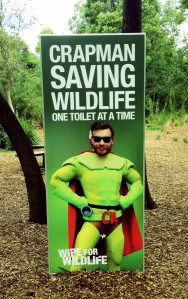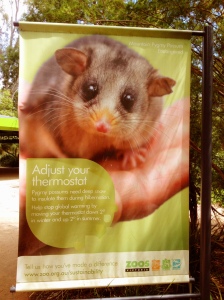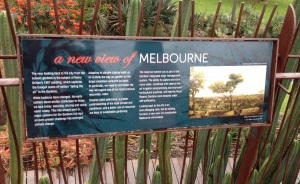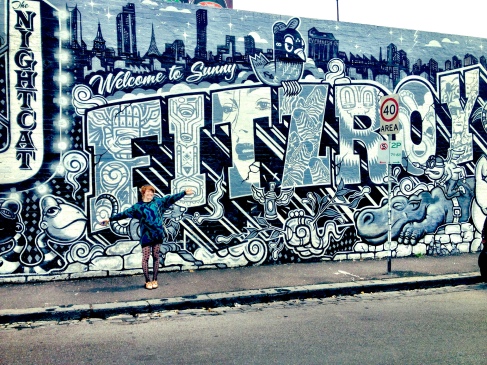Melbourne is a huge culture shock after Hong Kong. It’s a sprawling low rise mix of wild west and Berlin cool with stylish and disarmingly friendly residents. Vegetarian restaurants, bars, vintage stores and endless coffee shops line the graffitied streets of Fitzroy and laneways of the City, reminding me of Hackney or Montpelier in Bristol. Coffee is a serious business, brunch is the most important meal of the day and the north/south divide created by the Yarra river is a cultural as well as physical one. The weather is like an April day in the UK, flitting from bright sunshine, to intense cold wind to torrential rain in an instant. It’s familiar and strange all at once, both reminding me of home and the furthest away from it I’ve ever been.
It’s easy to see why Melbourne regularly gets voted the most livable city on Earth. The city is navigable, public transport workable, working hours seem reasonable and compensation adequate. The pace of life strikes me as one of gentle hedonism: a contented slow burn, fuelled mostly by (delicious) filter coffee and organic poached eggs. With my experience of urban living being the London lifestyle of sleep deprivation, intense highs, grinding lows and chaotic humanity, it’s surprisingly hard to get used to.
Comms and marketing are intriguing. There is a simple, direct and straightforwardness that is artless at times and refreshing at others. Common sense and straight talking are clearly valued. Sustainability communications seem few and far between. Those that I see are from familiar sources: local campaign groups, restaurants or in parks and fall into the usual camps of too rational, expressing ‘dos & don’ts’ signaling a premium, failing to connect action and consequence or misdirected humour.


So, here’s a summary of what I’ve learned:
- Australian history is fascinating: After a couple of days weaving in and out of vintage shops and drinking delicious fancy coffee (Proud Mary’s reputation is well deserved). I head to the Melbourne Museum to learn something about Australian history (a topic which I am woefully ignorant of). The aboriginal exhibition is frustrating at first, assuming knowledge which, as a Brit, I just don’t possess and alluding to a sensitivity which I therefore can’t initially comprehend. Displays interview living aborigines on subjects such as culture, possessions and respect and captioned objects suggest an approach to both art and culture which hasn’t changed much over thousands of years. Those that feature in the exhibition are articulate and fiercely proud of their heritage. The horrifyingly recent reality of the ‘White Australia’ immigration policy and the ‘Stolen generation’ of Aboriginal children is an insight into the divisions within Australian society and are currently front and centre in Australian politics. It is obvious that Australia has its own issues and a rich cultural heritage that is very different to ours, no matter how similar the culture might initially seem.
- 9bn people can’t want the same stuff: In the aboriginal exhibition, I find a placard that neatly puts into words the uneasiness I felt about the proliferation of Western brands in Hong Kong and the ubiquity of the hipster sensibility:
“Each of our different family groups or clans have different totems. Gilgar Gundtij- our totem is the emu. So we don’t eat the emu. Our neighbouring tribal family group, the Kerrupjmara, their family totem is the diamond headed snake, so they don’t eat that, but they eat the emu. And of course, if we were hungry, we would eat the diamond headed snake..”
To someone who loves the experience of different cultures, this convergence of tastes, desires and aspirations just feels wrong. Also, when coupled with the increasing population, the demand for the same things is presumably increasing resource pressures for products such as coffee. I know, from previous work that companies such as Nescafe and Cadbury’s have already predicted this and are taking action with programmes such as the ‘Cocoa Plan’. However, it makes me think that growth strategies that don’t respect and encourage cultural diversity are inherently unsustainable.
- Points of wonder are being used as ‘epiphany moments’: Another enormous difference from home is the exotic, colourful and totally alien flora and fauna. A visit to the Yarra Valley Healesville Sanctuary means meeting wombats, Tasmanian devils (sinister with sharp teeth and blood red ears), dingos, koalas and evil looking snakes and the Royal Botanical Gardens are beautiful. Half way up Guilfoyle’s volcano, there is a sign showing a view over Melbourne when it was built, to be compared with now. It then attempts to link the development of Melbourne (and our human impact) to climate change. Back at Healesville, they try it too, with signs asking visitors to ‘Wipe for Wildlife’ and using the dodgy ‘Crapman’ to promote recycled toilet tissue. The parks and zoos are trying to use the wonder and excitement of discovery as epiphany moments: moments which change points of view or behaviour, which OgilvyEarth’s Mainstream Green research found to be really important in forming people’s points of view on sustainability.
The issue here is that it’s not always executed well. The messaging I saw was still too rational and often too literal. Humour, such as the oddly named ‘Crapman’ doesn’t really work and aspiration isn’t always used correctly (no one wants to be a ‘tosser’ but then I doubt anyone wants to be a ‘Watersaver’ either). Australia’s natural beauty and unusual fauna presents such an opportunity to create these epiphanies, but need to inject more emotion and create a clearer call to action to be truly successful.

My own epiphany comes whilst drinking beer late on in the week and pressing my friends about livability. I express doubts about Melbourne’s pace of life, and probe them about whether it is ‘enough’ for them after London. Surely this is a utopia and not a genuine alternative to London life? In response to the questioning he sips his beer, sighs a relaxed sigh and responds that he would find it hard going back to London, oscillating between a 1 and a 10 all the time, knowing that life could be a constant 7 to 8. Would I swap crowded tube journeys, incredible nightlife, sleep deprivation, cutting edge galleries and mass of humanity for this fun, chilled, smaller town lifestyle? Yes, I probably would.
Places to visit (that I can remember the names of): Vegie Bar, The Night Cat, Proud Mary, Huxtaburger and Huxtable, The Tyranny of Distance, ‘No Lights, No Lycra‘ (it will change your life)


Great post me dear – enjoyed the Londoner’s perspective! I’ve heard Melbourne being compared to Berlin before (by a born and bred Melbourner who’s spent a lot of time in Berlin) so I think I’ll like it! Interesting to get the lowdown on the sustainability marketing agenda as I’m hoping to get back into green marketing when I move out there. Guess they’re not selling the sizzle yet then? 😉 I’ve heard climate change mitigation is quite big out there…interesting. Can’t wait to move out there – even more so after reading this! How long will you be there? Sounds like you’re having a fab time! Anna x
There’s def a need for some good corporate (issues) comms around sustainability as far as I can see, although this is all based on what I saw, rather than rigorous research. I’ve left now, in Brazil via Sydney but let me know how you get on!! They need sizzle and a dialogue around normality. When you moving? Very exciting! X
Cool, yeh can see why you got that impression with ‘crapman’ ha! I’m leaving at the end of Dec, so will start the new year afresh in a new country. Can’t wait! Much as I love London, I feel it’s time for a change 🙂 sounds awesome, enjoy your trip! Great blog – the title perfectly summarises the travel experience 😉 x